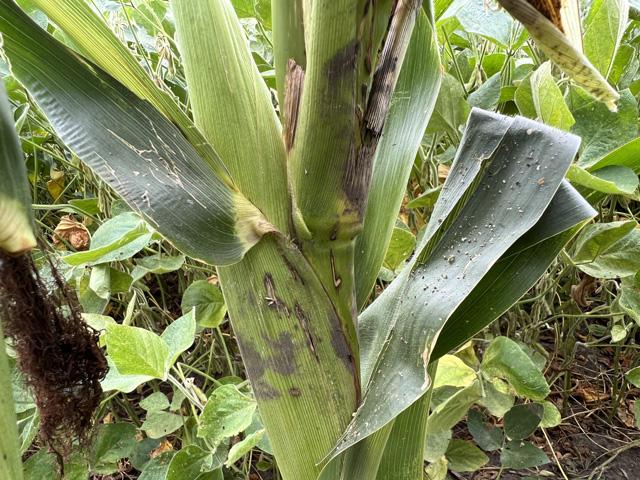What's That Black Crud in My Corn?
Excess Pollen Isn't a Disease or Concern, but Might Bring Hover Flies
EL PASO, Ill. (DTN) -- When a farmer brought Jim Schwartz a corn stalk to assess at a field day last week, the agronomist for Beck's Hybrids was more than happy to oblige. He was even more pleased to report that the black gunk in the leaf whorl was nothing more than fungi feeding on pollen that had fallen there.
While there are plenty of corn diseases that can be troublesome this time of year, the phenomenon known as purple leaf sheath isn't one of them. The non-destructive condition can create dark lesions that can vary in color from purple to brown to black. The lesions are not specific to any hybrid. Plants are often scattered and random within the field. The condition doesn't spread from one plant to another either.
Schwartz, who is Beck's director of research, agronomy and practical farm research (PFR), said the symptoms develop after the VT tasseling stage as falling pollen gets caught in the cracks and crevices of the corn plant and starts to rot. Pieces of the tassel and other debris attract yeast and saprophytes fungi that feed on the deposits.
If corn had a belly button, this would be the lint.
"You might peel the leaf sheath and see this black or purplish speckling. Sometimes it's on the stalk and sometimes it's not. We get questions about it every year, and it's almost always cosmetic and doesn't influence yield. A fungicide will not make a difference with this issue," Schwartz said.
CLEAN-UP CREW
However, if you see purple leaf sheath, don't be surprised if you also notice hover flies and their larvae. Sometimes called corn flies, hover fly adults are often misunderstood because they have the coloring and appearance of a bee.
Relax -- hover flies don't sting people, nor does the larval form of the hover fly -- a small, rather plain-looking maggot -- injure the crop. The maggots can resemble spent pollen anthers, so they sometimes generate some ick reactions when discovered wiggling about in leaf axils and other areas where pollen collects. However, they are just doing their jobs by dutifully cleaning up the field of excess pollen, according to a Purdue University news release issued a few years ago when hover flies had a particularly large breakout moment. Read it here: https://extension.entm.purdue.edu/… and in DTN's article https://www.dtnpf.com/….
P[L1] D[0x0] M[300x250] OOP[F] ADUNIT[] T[]
TAR SPOT MANIA
Concern over tar spot has more farmers out looking behind their corn ears this year, added Jon Skinner, a Beck's regional agronomy manager. Early alarms that tar spot had been found in some states ratcheted up concerns earlier in the season, but drier weather seems to have calmed things so far.
"We aren't in the clear yet. The corn has a lot of time to go, and it is still really green," Skinner said. "But this is about the time we saw it come in last year when we got some rainy spells and cooler nights and days -- kind of like the weather stretch we are going into right now around central Illinois," he said.
"Anytime we get the right environmental conditions, and we've got the corn out there, and we have inoculum loaded in the soil, it can infect that plant," he said. "My guess is we haven't seen much of it so far because a lot of growing areas were dry in June. This disease needs leaf wetness to infect."
The tiny raised black spots of tar spot can be found scattered on both sides of leaves, even moving onto husks and leaf sheaths in severe cases. Sometimes, a small halo-like feature appears around the spots, known as a fish-eye lesion. Unlike other spot-producing diseases such as the rusts or even insect frass, tar spot lesions cannot be scraped off the leaf tissue easily with a fingernail.
Read more about scouting for tar spot here: https://www.dtnpf.com/….
SEEING OTHER SPOTS
Physoderma brown spot is another disease that can be confused with purple leaf sheath. It is an infection that occurs when persistent heavy rains occur in the spring while plants are still in the vegetative stages of growth.
This disease generally appears round, like polka dots and sometimes presents a chocolate brown stripe down the rib of the corn leaf. Infection of the node can result in a brown to black decay -- another reason it is sometimes confused with purple leaf sheath. But in the case of Physoderma brown spot, the infection can lead to loss of stalk integrity. Fungicides won't reverse Physoderma brown spot but knowing if it is present can be important for harvest scheduling, the Beck's agronomist noted. There are also some rotational considerations for subsequent production years if the disease has been present.
There are many pathogens, fungi and bacteria affecting corn production. The following link from Corn ipmPIPE offers more information and maps to track weather-dependent diseases: https://corn.ipmpipe.org/….
PAYS TO ASK
Still uncertain about what black spot is in the field?
No question is too small in corn production, Schwartz said. "We keep learning every day. That's what makes this job so fun," he added.
Farmers are encouraged to work with area agronomists, seed dealers and university specialists if they have agronomic questions. For a list of university plant laboratories that do diagnostic work go to: https://www.npdn.org/….
Pamela Smith can be reached at pamela.smith@dtn.com
Follow her on Twitter @PamSmithDTN
(c) Copyright 2022 DTN, LLC. All rights reserved.





